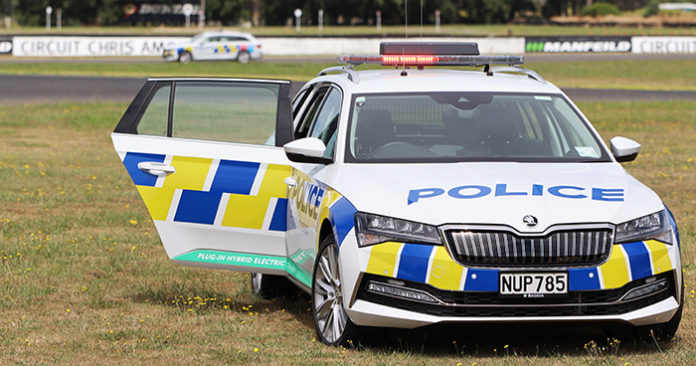NZ Police is set to start operational testing of a hybrid frontline car as a step toward reducing the organisation’s carbon footprint.
The PHEV – standing for Plug-in Hybrid Electric Vehicle – is a version of the Škoda Superb, so will be familiar to Police staff, says Manager Fleet Service Group, Inspector Brian Yanko.
A car, in full livery, will be moved around to be taken out on duty by frontline staff to test its capabilities in a range of operational settings and to seek their feedback on its performance, he said.
The full trial follows a range of tests including radio frequency interference, brake and road trials as well as performance testing at Manfeild, where it reportedly performed well with the added weight of Police kit and equipment.
The PHEV can run like other hybrids on petrol or battery, or a combination of the two. The ‘PH’ indicates its battery can be recharged from a regular wall socket, without the need for a dedicated charging station.
Insp Yanko says it’s expected the PHEV will be suited to frontline duties in an environment allowing for downtime during which it can recharge, a process which takes around seven hours from a standard 240-volt wall outlet.
“There is an expectation on us to decarbonise our fleet but vehicles have to be fully operational and fit for purpose to meet our operational requirements,” he said.
“That means they need to help keep our people safe and the New Zealand public safe.
“No vehicle gets a free pass. We won’t put it in the fleet because it’s cool and trendy – it has to meet our operational requirements.”
He says the PHEV would not be suitable for a 24/7 metro environment “where the engine never cools down” but looks likely to meet the needs of staff in other urban or rural settings, or for example in community roles.
“With a long-distance range capacity of 930km, we think this will be more than enough.”
Police has already bought three Superb iV PHEVs. One has been designated an Executive pool car to meet a requirement that Government agency leaders should drive decarbonised work vehicles; and an unmarked operational vehicle will also be put through its paces.
This work is one facet of work following through on Police’s commitment to reduce the environmental impact of its fleet, which is currently around 3,500 vehicles, including around 2,200 liveried patrol cars, Police said in a statement today.
The long-term intent is to adopt non-petrol/decarbonised vehicles as advances in technology make them able to meet the requirements of the many roles performed by our fleet, it said.

Full charging takes around seven hours from a 240-volt socket.
Fleet is in discussions with Škoda NZ around its Electric Vehicle programme and future models due to be released in New Zealand.
The NZ Police Fleet management group is also monitoring other vehicle manufacturers and police jurisdictions, such as the UK, where fully electric vehicles are being used in the operational environment.
“We are interested in anything that has potential to meet the requirements of frontline and other areas of policing in New Zealand,” said Insp Yanko.
In a separate area of work, Police is looking to soon test various EV makes and models to act as pool cars, for non-operational use.
They will be based at Police centres around the country which can have support infrastructure such as charging stations installed, or could be upgraded. Police Fleet and Property Group are currently working to identify these sites.
The initiative is part-funded by the Energy Efficiency and Conservation Authority (EECA), the branch of Government supporting the Public Sector in reducing carbon emissions – including a push to encourage use of EVs.
The petrol-engine Škoda Superb patrol cars currently being introduced produce 25-30% less carbon than the Holdens they are replacing, says Brian.
The fleet, including motorcycles, boats and helicopters, produces approximately 70% of Police’s carbon emissions.
Škoda Superb iV specs:
- The Superb iV wagon combines a 115kW 1.4-litre four-cylinder petrol engine with an 85kW electric motor and a 13kWh traction battery, producing a combined output of 160kW and 400Nm of torque.
- It offers up to 62km of electric driving range and a long-distance capacity of up to 930km, combined fuel efficiency of 1.4L/100km, combined CO2 emissions of 33g/km and a zero-100km/h sprint in 7.8 seconds.
- iV stands for ‘intelligent vehicle’.




